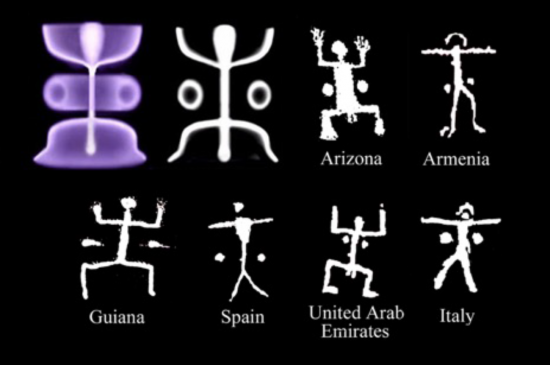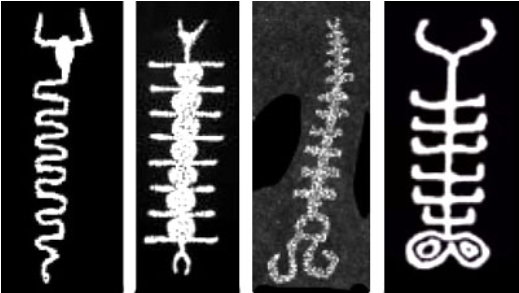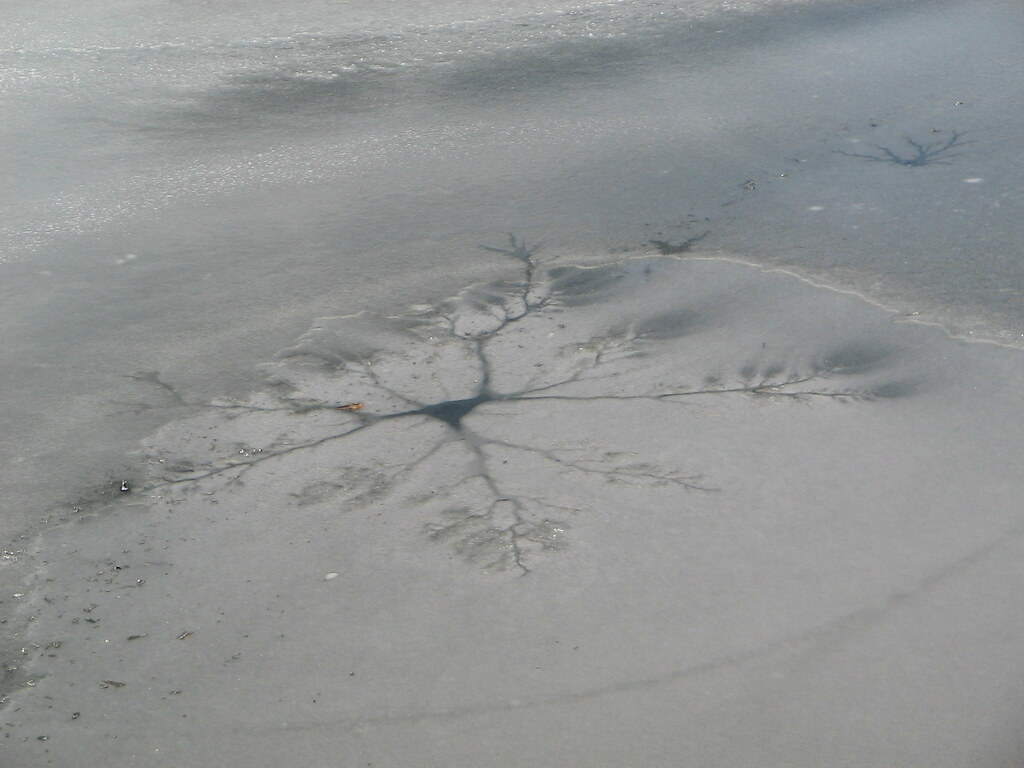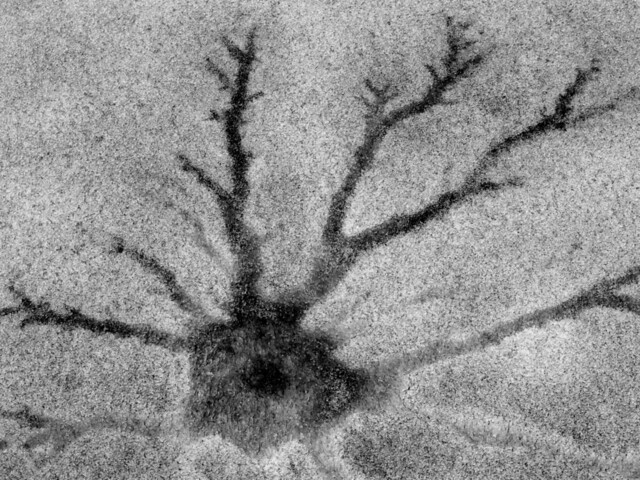Wolf-Rayet 140 (WR 140) [Image Credit: NASA, ESA, CSA, STScI, NASA-JPL, Caltech]
vs. nested "plasma double layer" shells produced in the SAFIRE Project (phase III) test chamber [Image: video screenshot].
It never ceases to amaze me, the absolutely remarkable things that end up going unremarked. Well, it's about high time to remark upon one...
I've meant to post this blog or something like it for a long time, but had hoped one of my online colleagues would have stepped up to the plate with a more technical analysis, from our point of view, by now...
Thus far, it hasn't yet happened. So, you'll have to bear with my non-technical 'looks like' analysis.
(Yes, I'm fully aware, 'looks like' doesn't necessarily mean 'is.' But ... I think this comparison nonetheless bears further rigorous investigation. Since, if 'looks like' turns out to be 'is,' it can tell us something extremely interesting about the cosmos, IMO. Possibly even something paradigm-shifting...)
So, not-so-long-ago now, the James Webb Space Telescope [JWST] team put out one or more press release(s) and published a paper or two in the journal Nature, which were picked up by the likes of news outlets such as Space, et al, regarding a novel observation of the Wolf-Rayet star "WR 140" (AKA, "Wolf-Rayet 140").
They noted that JWST had observed a heretofore unknown feature / structure unique to the the space around WR140. Specifically, they had captured an image of faint, somewhat ghostly, "bizarre rings" around the putative binary star system.
But, more than just 'rings,' Ryan Lau (Assistant Astronomer at the National Science Foundation’s NOIRLab, and principal investigator of the Webb Early Release Science program that observed WR 140) is quoted as saying:
"I was amazed. Although they resemble rings in the image, the true 3D geometry of those semi-circular features is better described as a shell."
Not just one shell mind you, but at least 17, if not more. The feature is structures a bit like an onion, with layers inside layers inside layers (at least 17 [and counting?]).
The question, my dear readers, is how we *interpret* the novel observation.
The team has forwarded a hypothesis regarding binary stars, solar winds colliding every 8 years or so and pushing out shells of dust in a somewhat spiral / conchoid manner, that then manages to somehow turn into this extremely regularly structure of nested spheres.
I, on the other hand, immediately likened the structure to something *entirely different* and altogether familiar to me: a specific novel result reported in several presentations about experiments done at the SAFIRE Project lab (testing the Electric Star / Electric Sun hypothesis, forwarded by retired professor of electrical engineering Donald Scott).
Not only was it a novel result, but it was actually initially observed & reported *prior* to the JWST observations, at least as early as 2015. Though the initial unrefined observations [below] occurred in Phase I of the SAFIRE Project, which may have {?} completed earlier than the 2015 conference presentation relating to Phase II of the SAFIRE Project:
Early images from the SAFIRE Project (Phase I). [Image: Composite of video screenshots.]
More refined observations and control of the plasma double layers came slightly later, as in this still frame from a presentation in 2017 (video of the evolving double layer shells in the experiment is slightly later, at this timestamp):
Later, more refined & controlled nested spherical "double layer" shells
inside the SAFIRE Project test chamber. [Image: video screenshot]
The JWST observation, however, was not reported until late 2022 (fully 7+ years after the SAFIRE Project had initially observed presented its experimental observations in 2015 [or earlier]).
So, for me, unlike for the JWST team, there was little if any "shock" or "surprise" at their observation of such a multi-shelled structure around one or more stars.
In fact, to my mind, to the contrary, it should be an *expected* observation around stars, *under specific electrical/plasma conditions*, commensurate with the prior experimental observation in the SAFIRE Project test chamber, *if the Electric Sun/Star hypothesis is true and/or the experimental results obtained in the SAFIRE Project test chamber are applicable/scalable to stellar and/or cosmological scales.* [And we already know that plasma behaviors, and structures are scalable, spatially and temporally, over many O.O.M. (orders of magnitude).]
And, just as in the JWST observation (from Ryan Lau, previously quoted):
"I was amazed. Although they resemble rings in the image, the true 3D geometry of those semi-circular features is better described as a shell."
SAFIRE Project lead Monty Childs described the evolution of the Double Layer shells thusly, in his earlier 2016 presentation:
"...And these, uh, these 'double layers' ... We ended up finding that we had two, three, four, ... twenty. {!} These aren't, uh, disks, these are spherical, um, discharges. Plasma has a unique characteristic where it's translucent as you look through the center of it, and it looks like it's a disk. But, in fact, it's not. What you're looking at, actually, are spheres."
Not only are the 'double layers' spherical in the SAFIRE Project test chamber, but you can get more than one shell... 2, 3, 4, ... 20! Again, just as in the JWST observation of [at least] 17 currently observable concentric shells around WR 140...
Electrical effects in plasma can *directly* and *reproducibly* generate *precisely* the multi-shelled structure observed by JWST [7+ years after the SAFIRE Project results].
In my opinion, this should probably be headline news.
There should at least be a reasonable, reasoned discussion of the SAFIRE results / observations and their potential applicability to stellar atmospheres [precisely the domain it was designed to investigate], and to the cosmos at large. Presumably the SAFIRE Project team could give some insight into what they observed in the test chamber, under what specific discharge regimes, and thus what specific characteristics to look for in astrophysical observations of WR 140 in order to further investigate, differentiate between the models, and decide which theory/explanation most accurately fits/explains empirical observation.
Further, should the result/correlation be upheld, it nigh demands a careful reconsideration of some basic tenets of modern stellar theory and likely cosmology at-large, since this experiment stems not from the 'Standard Model,' but instead from the 'Electric Universe' / 'Electric Star' Model(s), wherein the prime mover and shaker of the cosmos is not the exceedingly weak force of gravitation, but the 39 OOM stronger [that's 10^39 or a 1 with 39 zeroes after it {!} times stronger] electromagnetic force...
In that model, the 'galactic web' is not 'neutral' or 'dead' but a network of interconnected 'power lines' [of a sort] lighting up, well, basically EVERYthing (stars, galaxies, etc.). Far more can be said on that, but I'll confined my remarks to the subject at hand for now, as a microcosm of the macrocosmic issue(s) at hand.
Given recent apparent falsifications of the Big Bang (fully formed galaxies with too high a redshift, thus allegedly "too mature, too early after the [alleged] Big Bang") and other tenets of the 'Standard Model,' it's about time to shake things up, and shift our thinking to a new paradigm.
In my considered opinion, that is some flavor of Electric Universe, Plasma Cosmology, Magnetohydrodynamic Universe, Electrodynamic Universe, or however you bloody well want to phrase it.
It's all the same song and dance. And it's time to do the Electric Slide/Boogie, 'cause ... according to They Might be Giants: "The Sun is a Miasma of Incandescent Plasma..." [Well, you're almost there, anyway! Just a few steps more...] Sing us out, boys!

.jpg)
.jpg)
































